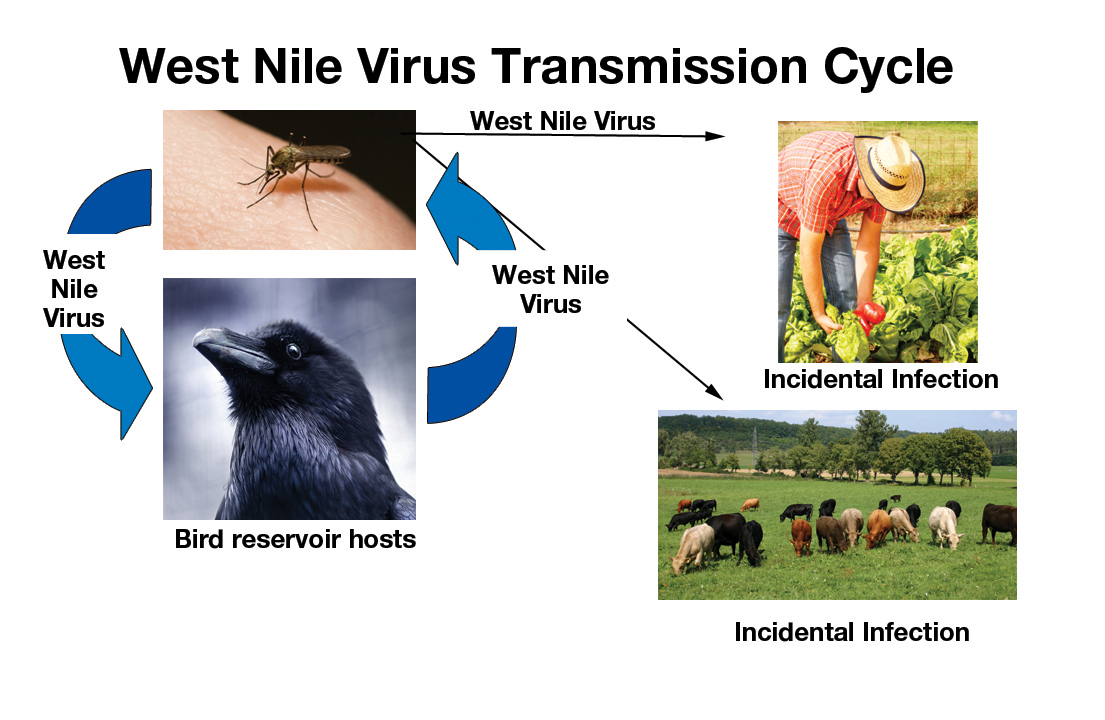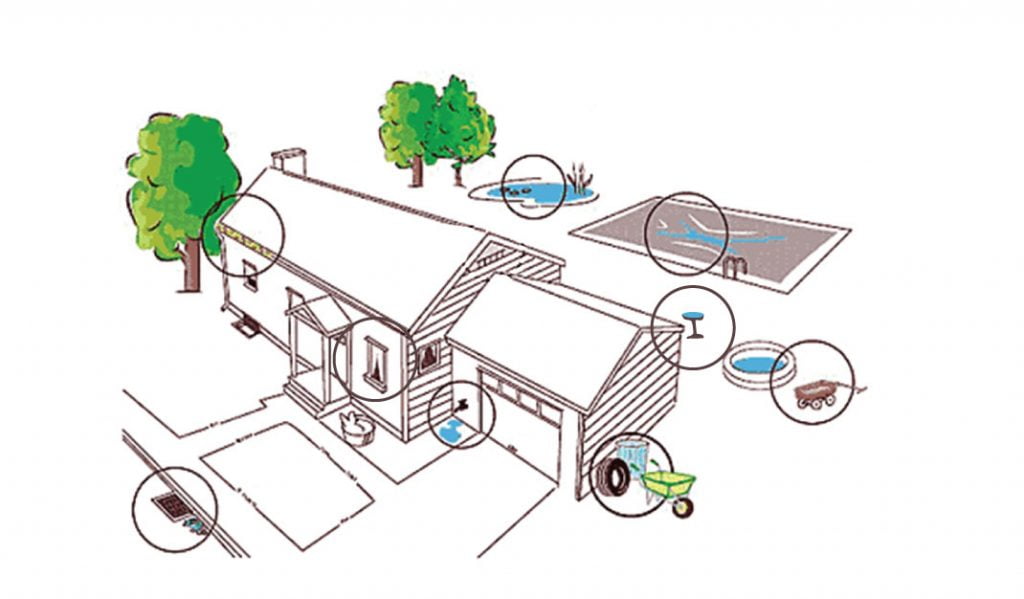- Home
- Health Topics
- Diseases
- West Nile Virus
West Nile Virus
What is West Nile virus?
West Nile virus is a virus mainly transmitted to people through the bite of an infected mosquito. Mosquitoes transmit the virus after becoming infected by feeding on the blood of birds which carry the virus.
Most people infected with the virus have no symptoms or they have flu-like symptoms, such as fever, headache, body aches and fatigue. Sometimes though, the virus can cause severe illness, resulting in hospitalization and even death. Symptoms usually develop between two and 15 days after being bitten by an infected mosquito.
The chances of getting West Nile virus from an infected mosquito are low. While anyone can become infected with West Nile virus, the risk of severe illness increases with age. The risk of becoming infected is greatest during mosquito season. In Canada, this can start as early as mid-April and last until the first hard frost in late September or October.
How can you protect yourself and your family from mosquito bites and West Nile virus?
Use insect repellent when outdoors.
- Choose an insect repellent that contains DEET or other approved ingredients.
- The concentration of DEET should be no greater than 30% for adults, no greater than 10% for children, and should not be used on children under six months old.
- Always read the label directions prior to usage.
Cover up.
- Wear light-coloured clothing, a long-sleeved shirt, long pants and a hat to go outside when mosquitoes are most active.
- Minimize your time outdoors at dawn and dusk when mosquitoes are most active.
- If it’s particularly bad out there and you need to be out for a long time, consider specialized bug-protective clothing.
Clean up and ruin a mosquito’s love life.
- Unlike birds and other insects, most mosquitoes do not fly very far and tend to stay close to their breeding sites and normal habitat.
- Mosquitoes lay their eggs in stagnant water – even small amounts. The life cycle from egg to adult can take less than 10 days.
- Get rid of as much standing water as you can from around your home and property. Drain water from flower pots, wading pools, old tires and so on. Change water in birdbaths and pet bowls twice a week.
- Make sure door and window screens fit tightly and are free of holes.
Top ten mosquito breeding sites
- Bird baths
- Old tires
- Unused containers like barrels
- Flower pot saucers
- Swimming pool covers
- Wading pools
- Clogged gutters and eavestroughs
- Clogged drainage ditches
- Small containers like cans or bottle tops
- Unused children’s toys or vehicles.
History of West Nile Virus
West Nile virus was first identified in the province of West Nile, Uganda in 1937. Since then the virus has been identified in Egypt, Israel, Asia, South Africa, parts of Europe, Australia and now, North America. In 1999, West Nile virus was found in New York state and, in 2001 the virus was discovered in birds in southern Ontario. Today, West Nile virus is considered endemic in Ontario.
Transmission
Infection occurs through the bite of an infected mosquito. The virus itself is maintained in nature through a cycle between various mosquito species and birds. The birds are amplifying hosts, developing sufficient viral levels to transmit the infection to other mosquitoes which then go on to infect other birds and humans. In the Western Hemisphere the American robin and the American crow are the most common carriers.
Similar to Eastern Equine Encephalitis virus (EEEv), the amount of virus found in nature increases throughout the summer as more birds and mosquitoes become infected. Humans, horses and other infected mammals are considered dead-end hosts as they do not circulate enough virus within their blood to infect additional mosquitoes. Horses can and should be vaccinated against EEEv and WNv.

(click to enlarge graphic)
Symptoms
There are three stages of West Nile virus infection. The table below gives a brief description of each stage.
Asymptomatic Infection | West Nile Fever | West Nile Meningitis or Encephalitis | |
|---|---|---|---|
Susceptibility | Approximately 80% of those infected | Approximately 19% of those infected | Approximately 1% of those infected |
Symptoms | No observable symptoms. | This febrile stage has an incubation period of 2 to 8 days followed by fever, headache, chills, excessive sweating, weakness, swollen lymph nodes, drowsiness, pain in the joints and flu-like symptoms. Some patients experience gastrointestinal symptoms including nausea, vomiting, loss of appetite, or diarrhea. Most symptoms are resolved within 7 to 10 days. | With more severe illness, symptoms may include the rapid onset of severe headache, high fever, stiff neck, nausea, difficulty swallowing, vomiting, drowsiness, confusion, loss of consciousness, lack of coordination, muscle weakness and paralysis. Other symptoms that have been identified include movement disorders, parkinsonism, poliomyelitis-like syndrome and muscle degeneration |
Persons of any age or health status can be at risk of developing serious health effects from West Nile virus. However, the overall risk of serious health effects increases with age. Those with weaker immune systems are also considered to be at greater risk for serious health effects.
People at higher risk for serious health effects due to becoming infected with West Nile virus include:
Treatment
Unfortunately, there is no vaccine and no specific treatment for West Nile virus. Serious cases usually require supportive treatment to ease symptoms and prevent secondary infections. These cases may require hospital or nursing care.
Mosquito Repellent Use
Always follow the product’s instructions. Apply repellent to skin and clothing while avoiding open cuts, wounds, sunburned and/or irritated skin. Avoid breathing repellent in and if it gets in your eyes, rinse with water immediately. Avoid applying to children’s hands, face and eyes. Avoid prolonged use and wash repellent off daily.
For repellents containing DEET, Health Canada recommends the following:
Children less than 6 months of age | Children 6 months to 2 years of age | Children 2 to 12 years of age | Children 12 years of age or older | Adults | Pregnant Breastfeeding Mothers |
|---|---|---|---|---|---|
Do not use repellents containing DEET. Use other methods such as netting and avoid going out when mosquitoes are active. | Use a product containing 10% DEET or less. Maximum of one application per day. | Use a product containing 10% DEET or less. Maximum of three applications per day. | Use DEET as often as needed according to product instructions. | Use DEET based on amount of time protection required. 5% DEET= 2hrs 10% DEET= 3hrs Apply according to product instructions. | There is no evidence that use of DEET by pregnant women harms the fetus or affects a nursing child. |
Public Health Measures
The Health Unit’s comprehensive WNv program in Haldimand and Norfolk has been in place since 2000. Currently, the program involves human surveillance, mosquito surveillance, wildlife surveillance, larval mosquito surveillance and control as well as public education. These components enable the Health Unit to monitor WNv activity in order to determine the potential risk to human health in the area and act accordingly when and where necessary. However, public education will continue to be the cornerstone of the Vector-Disease Program in order to empower the public with the knowledge it requires to protect itself from WNv, Lyme Disease and EEEv.
Surveillance
Results regarding local and provincial surveillance measures can be found below.
Probable and Confirmed Human WNv Illness Cases
2000 | 2001 | 2002 | 2003 | 2004 | 2005 | 2006 | 2007 | 2008 | 2009 | 2010 | 2011 | 2012 | 2013 | 2014 | 2015 | 2016 | |
|---|---|---|---|---|---|---|---|---|---|---|---|---|---|---|---|---|---|
Haldimand-Norfolk | 0 | 0 | 3 | 0 | 0 | 0 | 0 | 0 | 0 | 0 | 0 | 0 | 5 | 0 | 0 | 0 | 1 |
Ontario | 0 | 0 | 394 | 89 | 14 | 101 | 42 | 17 | 4 | 3 | 6 | 56 | 236 | 56 | 12 | 34 | 53 |
Equine Confirmed Positive for WNv
2002 | 2003 | 2004 | 2005 | 2006 | 2008 | 2009 | 2010 | 2011 | 2012 | 2013 | 2014 | 2015 | 2016 | |
|---|---|---|---|---|---|---|---|---|---|---|---|---|---|---|
Haldimand-Norfolk | 9 | 0 | 0 | 0 | 0 | 0 | 0 | 0 | 0 | 1 | 0 | 0 | 0 | 0 |
Ontario | 101 | 9 | 9 | 5 | 3 | 2 | 1 | 0 | 8 | 6 | 11 | 1 | 3 | 2 |
Trapped Mosquito Pools Testing Positive for WNv
2000 | 2001 | 2002 | 2003 | 2004 | 2005 | 2006 | 2007 | 2008 | 2009 | 2010 | 2011 | 2012 | 2013 | 2014 | 2015 | 2016 | |
|---|---|---|---|---|---|---|---|---|---|---|---|---|---|---|---|---|---|
Haldimand-Norfolk | No testing | No testing | 6 | 1 | 0 | 1 | 0 | 1 | 1 | 0 | 0 | 0 | 1 | 1 | 0 | 0 | 0 |
Ontario | No testing | No testing | 598 | 137 | 69 | 291 | 182 | 51 | 62 | 14 | 57 | 286 | 464 | 198 | 56 | 94 | 211 |

